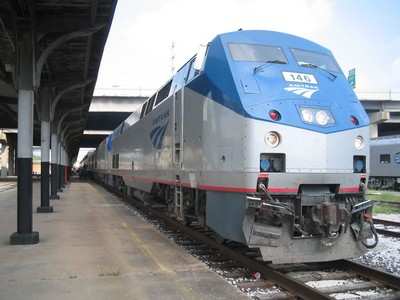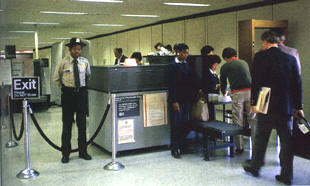Some Say Train Travel More Convenient, Less Expensive... And
Less Stressful
In these days of crowded jets languishing for hours on hot
tarmacs and irritated passengers growing more irritated at ever
increasing flight delays, there are some that have had enough and
are returning to the roots of long-distance travel.

No, not sailing ships, or stagecoaches -- trains.
According to the Wall Street Journal, ridership on the nation's
passenger rail system is up six percent so far this year --
reportedly the largest leap up since the 1970s. Those kinds of
numbers are music to the ears of many at Amtrak... the nation's
oft-maligned, arguably ill-funded rail provider.
Amtrak's Acela Express runs a line from Boston to New York to
Washington. The number of passengers has jumped 20 percent just in
the last 10 months. The Journal says that equals the number of
passengers it takes to fill 2,000 757s.
One reason for the switch in loyalties is the fact that security
lines, flight delays and cancellations make traveling by air
"an absolute horror show," as one disgruntled air traveler put
it.
Traveler Richard Rosen travels frequently for business and has
begun taking the Acela whenever possible.
He says a trip from Boston to New York, with traffic, delays and
security hassles can take four hours or more. But, the Acela takes
about three and a half hours and is much less stressful and
much more comfortable.
 "The train is much
better, and you can do your work and use your cell phone during the
whole trip," he said.
"The train is much
better, and you can do your work and use your cell phone during the
whole trip," he said.
Some are switching because they believe trains are not as
dangerous to the environment. Recent studies are suggesting
aircraft are more damaging than originally thought, as ANN reported.
Some are doing it because it's cheaper. A one-way non-discounted
fare for the New York-Washington on the Acela is $199, compared to
$324 for the same ticket on the same route on the air shuttle.
The improvement in Amtrak's numbers hasn't gone
unnoticed, either. "This means a lot of goodwill in the bank for
Amtrak among policy makers for increasing its funds and expanding
service," says Rep. James Oberstar, a Democrat from Minnesota and
head of the House transportation committee.
"The dynamics have shifted in favor of a strong future for
Amtrak."
The House passed a fiscal 2008 funding bill recently with $1.4
billion destined for Amtrak plus another $50 million that will
match state funding of some capital projects.
The Senate is considering $1.37 billion plus $100 million for
Amtrak's capital program.
So what does this have to do with aviation? As with any kind of
competition, there are critics and detractors. There are those,
like the Air Transport Association, who say a new air traffic
control system will fix what ails the air transport industry.
"If that is taken care of, a lot of the problems we have today
will be eliminated," says a spokesman for US Airways Group Inc.
 A JetBlue Airways
spokesperson added, "It's wrong for tax dollars to be used to
subsidize Amtrak passenger trains when a modernized
air-traffic-control system is not yet in place or even funded."
A JetBlue Airways
spokesperson added, "It's wrong for tax dollars to be used to
subsidize Amtrak passenger trains when a modernized
air-traffic-control system is not yet in place or even funded."
Then there's the other side of the proverbial coin. Some
surprising attitudes from some surprising sources are all for
building up America's rail system.
Robert Crandall -- former CEO of AMR Corp, parent company of
American Airlines -- says helping Amtrak grow and prosper,
especially in the Northeast (think JFK, Newark and LaGuardia) is
"one of the best" ways to reduce aviation congestion.
If trains are taking the short-distance travelers, that would
free up space for long-haul flights.
"You have to begin to put the infrastructure in place to put in
high-speed trains," said Gordon Bethune, former CEO of Continental
Airlines. "It should be a national priority. If the French can do
it, why can't we?"
 ANN's Daily Aero-Term (04.24.24): Runway Lead-in Light System
ANN's Daily Aero-Term (04.24.24): Runway Lead-in Light System ANN's Daily Aero-Linx (04.24.24)
ANN's Daily Aero-Linx (04.24.24) Aero-FAQ: Dave Juwel's Aviation Marketing Stories -- ITBOA BNITBOB
Aero-FAQ: Dave Juwel's Aviation Marketing Stories -- ITBOA BNITBOB Classic Aero-TV: Best Seat in The House -- 'Inside' The AeroShell Aerobatic Team
Classic Aero-TV: Best Seat in The House -- 'Inside' The AeroShell Aerobatic Team Airborne Affordable Flyers 04.18.24: CarbonCub UL, Fisher, Affordable Flyer Expo
Airborne Affordable Flyers 04.18.24: CarbonCub UL, Fisher, Affordable Flyer Expo





